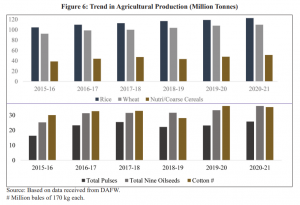
Global wheat prices soar: Global wheat output is set to fall this year after three years of steady rise due to the conflict between Russia and Ukraine which together account for a third of the global production of the food grain, according to the first estimates of global output by the US Department of Agriculture. The USDA estimates global wheat production to be 774.8 million tonnes in 2022-23 while the global buffer stock is at around 267 million tonne, the lowest in six years.
Wheat production in Ukraine this year is expected to fall by a third compared with the 21.5 million tonnes recorded last year. India, the second-largest producer of wheat, has announced a ban on exports as traders looked to book profits from an unprecedented 50% increase in global prices. While India’s wheat output could be impacted by a heat wave in March, China, the largest producer, is also likely to face a fall in production.
READ I People’s participation can prevent forest fires of Uttarakhand
No respite seen from high wheat prices in 2023
With major producers facing reversals, the wheat supply for 2023 is likely to decline to all-time low levels. This means, the global prices will remain high through 2023 fueling food price inflation, especially in importing countries. The rise in wheat prices is a major contributor to the runaway inflation in most parts of the world.

India’s ban on wheat exports to address its food security worries will have a bearing on global prices of the food grain. The Union commerce ministry said that the action was taken to address the food security risk due to soaring global prices. Indian traders cashing in on the global prices could have put billions of the nation’s poorest at risk.
India witnessed the hottest March on record which may have affected crops in Punjab and Haryana, two of the biggest producers of wheat. Private traders have procured wheat at high prices to meet the export demand. India is facing high food inflation – high prices could put food items beyond the reach of the country’s poor.
The soaring wheat prices have benefited Indian farmers with private traders offering prices higher than the minimum support price set by the government for food grain procurement. It is not normal for traders to offer prices higher than the MSP. The 50% increase in global wheat prices have made Indian wheat competitive in the international market. India consumes a major chunk of its wheat output. It had targeted to export 10 million tonnes of wheat in the financial year 2022-23 to cash in on the disruption in the global market.
India’s move to ban exports was taken fearing that the heat wave may damage crops. It’s normal for India to prioritise the needs of its population above exports as it faces runaway inflation in food and fuel segments. The government has promised to continue exports to countries importing to meet food security purposes. Indian may continue to export wheat to Bangladesh, Sri Lanka, and other countries in South Asia.
